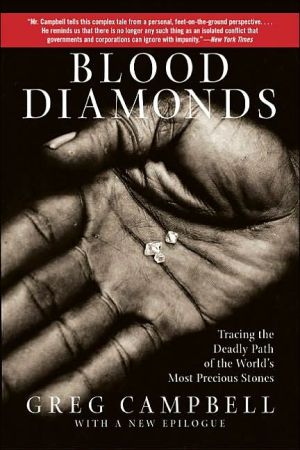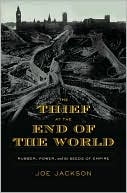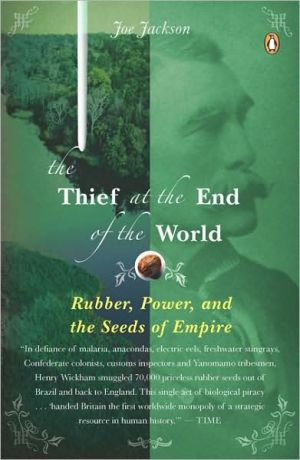Blood Diamonds: Tracing The Deadly Path Of The World's Most Precious Stones
First discovered in 1930, the diamonds of Sierra Leone have funded one of the most savage rebel campaigns in modern history. These "blood diamonds" are smuggled out of West Africa and sold to legitimate diamond merchants in London, Antwerp, and New York, often with the complicity of the international diamond industry. Eventually, these very diamonds find their way into the rings and necklaces of brides and spouses the world over. Blood Diamonds is the gripping tale of how the diamond...
Search in google:
Journalist Greg Campbell leads the reader down the international diamond trail of brutality, horror, and profit - providing an on-the-ground and in-the-mines story of global consequence Foreign Affairs Campbell, a freelance writer, sets out to rub the noses of diamond-lovers in the gore of Sierra Leone's brutal civil war (1991-2001), in which a rebel army of thieves seized the country's diamond fields and specialized in amputating the limbs of villagers to force their cooperation in the plunder. Arriving on the scene in 2001, Campbell interviewed survivors and observed efforts, often bumbling, by the UN's huge peacekeeping mission to stabilize the country. Is there a way to bar the sale of tainted gems on the world market? Ultimately no, the author says, given the ease of smuggling something with such low weight and high value. But this fact has not stopped the De Beers corporation, which still controls about 65 percent of world sales of uncut diamonds, from trying mightily to convince consumers that its diamonds are clean. At this stage, however, few consumers know about the villagers in Sierra Leone, or that al Qaeda laundered money by buying blood diamonds, or that Liberian President Charles Taylor, the Slobodan Milosevic of Africa, has remained in power largely through illicit diamond deals with the Sierra Leone rebels.
Prologue : impact : the price of diamonds1From pits of despair to altars of love12Diamond junction : a smuggler's paradise253The gun runners : from Tongo to Tiffany's594Death by diamonds : operation no living thing795The syndicate : a diamond is forever996Waging peace : taking the conflict out of "conflict diamonds"1397The way station : next stop, Liberia1658"The base" : Osama's war chest1839The rough road ahead : mining for peace203
\ Foreign AffairsCampbell, a freelance writer, sets out to rub the noses of diamond-lovers in the gore of Sierra Leone's brutal civil war (1991-2001), in which a rebel army of thieves seized the country's diamond fields and specialized in amputating the limbs of villagers to force their cooperation in the plunder. Arriving on the scene in 2001, Campbell interviewed survivors and observed efforts, often bumbling, by the UN's huge peacekeeping mission to stabilize the country. Is there a way to bar the sale of tainted gems on the world market? Ultimately no, the author says, given the ease of smuggling something with such low weight and high value. But this fact has not stopped the De Beers corporation, which still controls about 65 percent of world sales of uncut diamonds, from trying mightily to convince consumers that its diamonds are clean. At this stage, however, few consumers know about the villagers in Sierra Leone, or that al Qaeda laundered money by buying blood diamonds, or that Liberian President Charles Taylor, the Slobodan Milosevic of Africa, has remained in power largely through illicit diamond deals with the Sierra Leone rebels.\ \ \ \ \ Library JournalFreelance journalist Campbell here writes about the cost of diamonds not in dollars to the consumer but in blood, torture, and death for the unfortunate residents of contested mining areas in Sierra Leone. He explains that "conflict diamonds," or "blood diamonds," which account for only three to four percent of all diamonds sold, are mined in war zones, smuggled out of the country, and sold to legitimate companies, financing ruinous civil wars and the plots of international terrorists, including the al Qaeda network. The gems' value and portability have made controlling the diamond mines important to guerrilla fighters, who maim and kill innocent villagers to secure their territory. Campbell has spoken with individuals all along the pipeline, from miners to soldiers to smugglers, and the grim portrait he paints will make many people think twice about buying another diamond. While Matthew Hart's Diamond: A Journey to the Heart of an Obsession covered the international diamond trade more widely, this focused study of the catastrophic effect of blood diamonds on Sierra Leone belongs in all libraries. Deirdre Bray Root, Middletown P.L., OH Copyright 2002 Cahners Business Information.\ \ \ Kirkus ReviewsThe sorry role the diamond has played in the history of Sierra Leone, stunningly told by journalist Campbell (The Road to Kosovo, 1999). Sierra Leone is "a vacuum of violence, poverty, warlords and misery, a tiny corner of western Africa where the wheels have fallen completely off," writes Campbell, its politics as raw and unrelenting as the natural environment. But the country has lots of diamonds: it’s "diamondiferous." It was also home, until the beginning of this year, to a civil war, fueled by diamonds, wherein the Revolutionary United Front (RUF), which is neither revolutionary nor united, killed 75,000 people and mutilated another 20,000, turning 80% of the 5 million civilians into refugees. The war involved much murder, dismemberment, and gouging, and diamonds kept it going, gems destined to go not just to the De Beers consortium, but to Al Qaeda as well, a handy liquid asset that couldn’t be frozen and travels well: "Three hundred grams of diamonds are equal in value to 40,000 pounds of iron ore, but only one of those commodities can be successfully smuggled in one’s bowels." Campbell follows the murky trail of the gems from mine to mainstream as they’re taken from grubby pits in the rainforest—mined by what can only be called slave labor—carried by mule to Liberia, The Gambia, and Guinea, thence to the great diamond centers in New York, Israel, and the Netherlands. Campbell travels the breadth of Sierra Leone to gather his story—a savvy blend of history, mercenary operations, corporate shenanigans, and war reporting—surely putting himself in as much danger as Doug Farah, the Washington Post reporter who uncovered the Al Qaeda connection and had to leave West Africa hastily.Readers of Campbell’s horrific tale—from killing fields to corporate boardrooms and all the seedy, murderous, and pathetic characters that fall between—who don’t demand proof-of-source on any diamond purchase ought to have their ethics examined. (10 b&w photographs)\ \







